
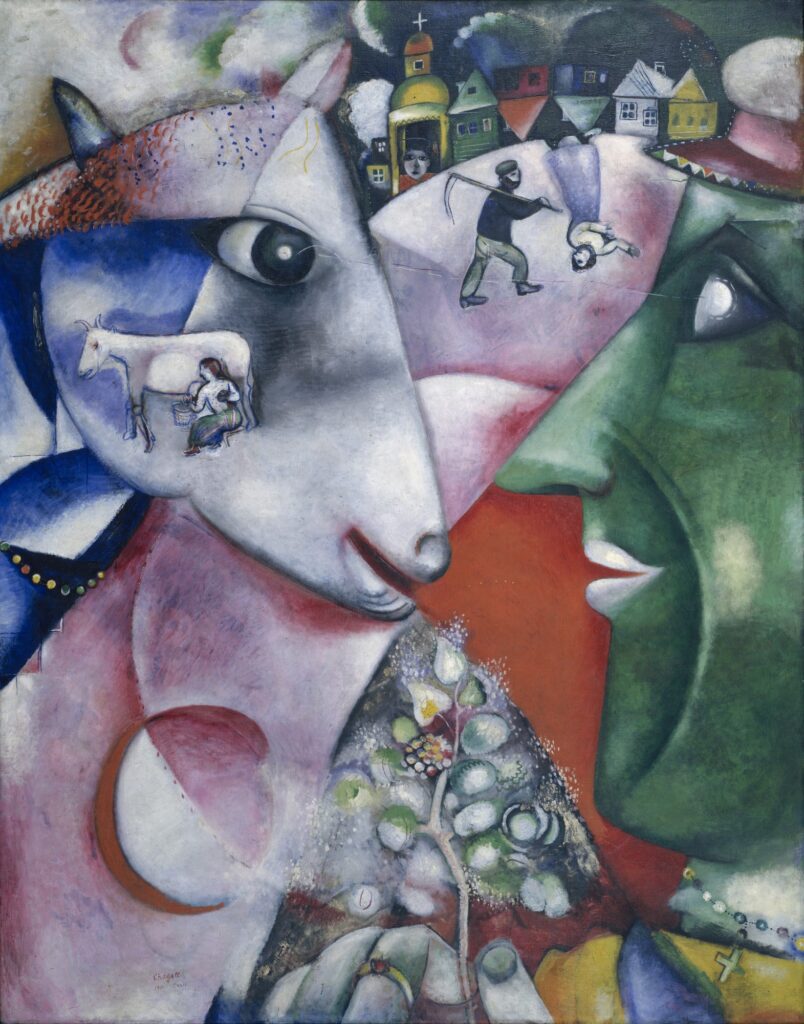
About the Painting
“The village and I” is the title of this painting by the artist Marc Chagall, and in it he painted a large profile of his own head.The animals were his friends, and he often used to talk to them. What do you think he is saying here to the white cow? Or is the cow telling him a story?
The picture, “The Village and I” tells many stories and is made up of different shapes and colours — like a Kaleidoscope in which new a pattern appears each time you turn it: small, brightly- coloured wooden houses, two of which are upside-down, a man looking out of the church with its round dome, a farmer walking across the field with a scythe, the farmer’s wife showing him the way, but wait, she is upside-down too! And the white cow appears twice in the picture.
The Village and I
The village is called Vitebsk and is really a small town in the Russian Empire with two rivers, bridges, churches, palaces and many wooden houses. Marc Chagall was born there on 7th July 1887.
Watch a short clip featuring Chagall’s Birthplace below:
The garden in front of his house is full of flowers, vegetables and herbs, and in the little farmyards and outbuildings there lived cows, pigs, horses, donkeys and chickens. The artist spent his childhood in a large family amongst all these animals, which are to be found again and again in his pictures.
Predating Surrealism, his early works, such as The Village and I (1911), were among the first expressions of psychic reality in modern art. His works in various media include sets for plays and ballets, etchings illustrating the Bible, and stained-glass windows.
Analysing the Painting: The Village and I
A picture of Vitebsk emerges from the many individual elements of this painting, although it is difficult to know whether Chagall is depicting a dream or drawing on actual memories. It not easy to tell apart, because Chagall’s head is always filled with images of his village — of the houses, the people and the animals— no matter where he happened to be living at the time.
Self-Portrait with Seven Fingers
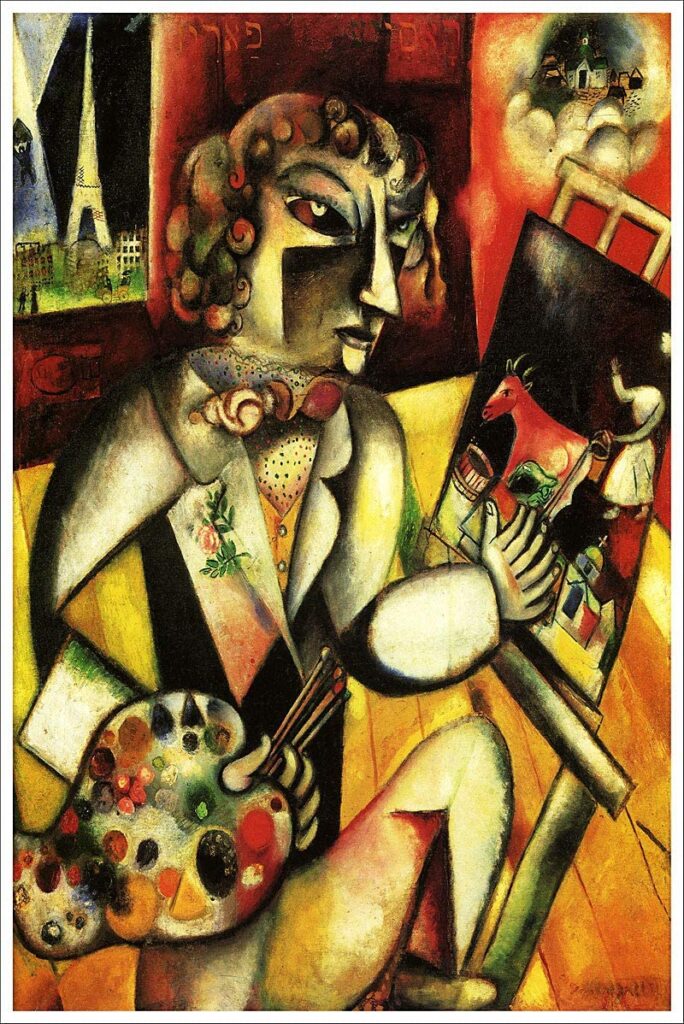
All dressed up, with a yellow waistcoat, a spotted shirt and a necktie, Marc Chagall sits in front of his easel. He has even put a rose in his buttonhole. In his right hand he is holding some paintbrushes and a palette covered with various paints — red, green, yellow, violet.
Despite the luminous yellows and deep red colours dominant in Chagall’s self-portrait, it’s impossible not to notice that his left hand has seven fingers, which means there’s two fingers too many, unless you’re in a psychedelic state of mind. There are many interpretations that explain why he painted seven fingers, but truth is, only Chagall knew.
His Life

Chagall moved from Russia to Paris. Many famous artists lived in the French capital at that time. He hoped to learn from them and eventually become a great painter himself. There, he met the avant-garde poets Blaise Cendrars, Max Jacob, and Guillaume Apollinaire, as well as a number of young painters destined to become famous: the Expressionist~ Chaim Soutine, the abstract colourist~ Robert Delaunay, and the Cubists~ Albert Gleizes, Jean Metzinger, Fernand Léger, and André Lhote.
Chagall was fascinated by he great city of Paris: the Eiffel Tower, the crowds of people, the cars, the numerous museums and the pictures by other painters. His head was also filled with memories of Vitebsk, its many animals and wooden houses.
Nor was there enough canvas to paint so many pictures. Since Chagall had very little money, he used table-tablecloths, sheets and even his nightshirt, cut them up into pieces and painted on them instead. All day and all night he painted pictures of Paris, Vitebsk and all his dreams and fantasies.






The Eiffel Tower
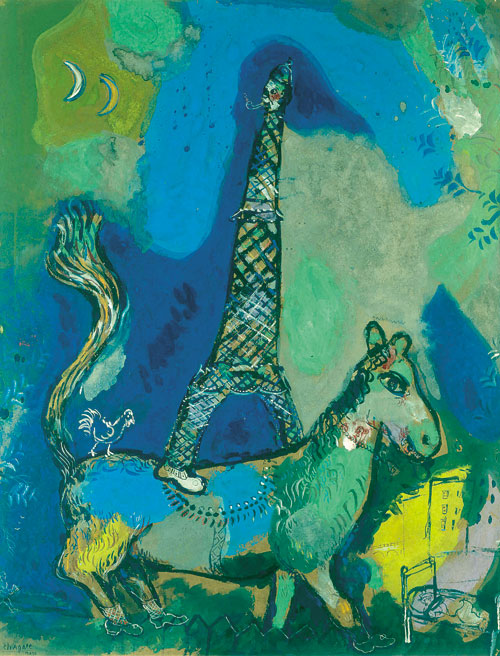
The four years of his first stay in the French capital are often considered Chagall’s best phase. Representative works are Self-Portrait with Seven Fingers (1912), I and the Village (1911), Hommage à Apollinaire (1911–12), Calvary (1912), The Fiddler (1912), and Paris Through the Window (1913). In these pictures Chagall was already essentially the artist he would continue to be for the next 60 years.
His colours, although occasionally thin, were beginning to show the characteristic complexity and resonance he would eventually achieve. The often whimsical figurative elements, frequently upside down, are distributed on the canvas in an arbitrary fashion, producing an effect that sometimes resembles a film montage and suggests the inner space of a reverie. Often the principal character is the romantically handsome, curly-haired young painter himself. Memories of childhood and of Vitebsk were major sources of imagery for Chagall during this period.
In the painting it looks like the The Eiffel Tower was tired of standing all alone, stretching high above Paris, where he could see Paris only from afar. He thought to himself: ‘There must surely be much more to discover in this city!’
So he put on a cap and shoes, and set off with a pipe in his mouth.As he was wondering where to go, a colourful donkey came along. There where bells hanging around his neck which jingled cheerfully when it walked. It also had a travelling companion: a cockerel, which can be seen wandering or flying through many of Chagall’s other pictures.
It did not take the Eiffel Tower long to make up his mind and set off with the two of them. Together, they wandered merrily through the blue, grey and green.
Where do you think they went?
Or, did the Eiffel Tower not really move at all? Isn’t it still there, standing all alone, high above the city?
Was it all a dream ?
Paris through the Window
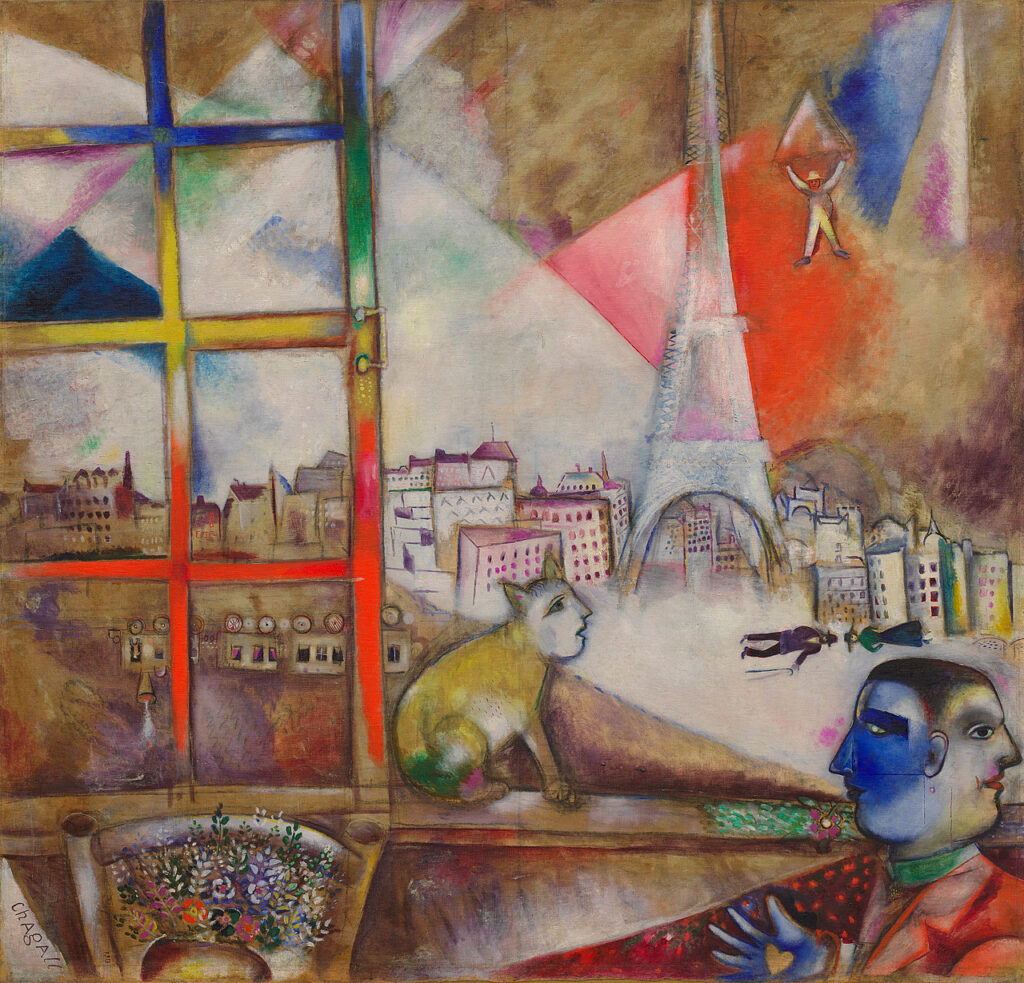
After Marc Chagall moved to Paris from Russia in 1910, his paintings quickly came to reflect the latest avant-garde styles. In Paris Through the Window, Chagall’s debt to the Orphic Cubism of his colleague Robert Delaunay is clear in the semitransparent overlapping planes of vivid color in the sky above the city.
What is on the outside and what is on the inside in this picture? The city of Paris, with the Eiffel Tower clearly recognizable, is separated from the inside of a room by a colourful lattice window. Perhaps we are looking out of Chagall’s studio.The outside world, the world that Chagall saw every day, was mixed up with his inner world, with his fantasies and dreams.
Chagall’s parachutist might also refer to contemporary experience, since the first successful jump occurred in 1912. Other motifs suggest the artist’s native Vitebsk. This painting is an enlarged version of a window view in a self-portrait painted one year earlier, in which the artist contrasted his birthplace with Paris.
About the Artist’s Life
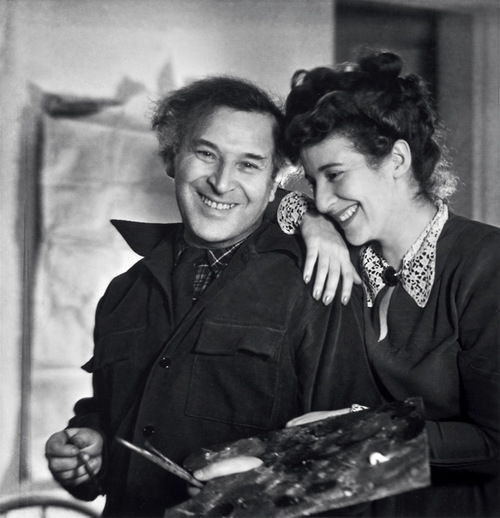
Marc Chagall was born on 7th July 1887 in Vitebsk, Russia. He had seven sisters and two brothers. His father worked for a fishmonger and his mother kept a small shop. Their hospitable house was always full of visitors. After attending elementary school, Chagall moved to St Petersburg to study under Leon Bakst at the Zvantseva School of Art.
From 1910 to 1914, he lived in Paris, where he had a studio in the Impasse du Maine and met many painters and writers. On 25th July 1915, in Vitebsk, he married Bella Rosenfeld, whom he never got tired of painting. In 1916, their daughter, Ida was born and three years later, Chagall founded an art school in Vitebsk. The Chagalls moved to Paris in 1923, but spent much of their time in the French countryside. From 1941 to 1946, they lived in America, where Bella died in 1944.
After returning to Paris, Chagall had many exhibitions and travelled extensively. In 1950, he moved to the south of France and, two years later, married Valentine (Vava) Brodsky, who enabled him to cam’ on painting in peace into his old age. Besides painting, he also designed stained-glass windows and stage scenery. On 28th March 1985, Marc Chagall died at the age of ninety-seven in Saint-Paul-de-Vence near Nice.

[…] Photos that Sell and Resell Photography Tips to Help you Produce some Stunning Portraits Psychic Reality in Modern Art : My First Expression~Marc Chagall “To be, or not to be, that is the question” Quoting William Shakespeare Why the World loves […]